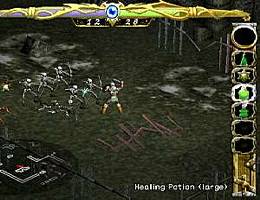
Well I think I’m done with Record of Lodoss War. I’ve been playing it off and on for about two weeks now and I’ve had it. It’s a frustrating game where death is frequent; I must’ve saved every three minutes in the seven hours I’ve logged, and you know what I’ve just realized? There isn’t a good enough sense of payoff for me to continue playing, so I’ll stop.
Record of Lodoss War is an action RPG, developed by Neverland and released on the Dreamcast in early 2001 here in the US. The game is based off of a Japanese anime/manga and having no previous experience I’m unaware how, if at all, this relates to the source material. Judging from the setup though, it seems that the game is meant as a side or alternate story. You control The Hero, who has been brought back from the dead. A bad dude has been doing some bad stuff, like deciding to revive an ancient beast that will do his bidding and destroy, destroy, destroy. This is why The Hero has been resurrected, you see, in his past life he was a great warrior and a wise wizard believes he’ll be able to stop this evil. This wizard, Wart, initially sets you up to take over a goblin settlement which then becomes home base, a safe spot to return and do some blacksmithing. The Hero’s quest is ultimately to stop all the bad guys and as far as I proceeded on his quest, I met a few allies and visited a couple of towns and plenty of dungeons. The story seemed dense with detail and it would appear that knowing more about the source material would lighten the load but regardless, the story didn’t capture my interest.
Talking about the gameplay, Record of Lodoss War shares a lot with Diablo. You control The Hero in real time, explore dungeons, do some blacksmithing, etc. Battling enemies usually ended up a frustrating experience. I’d line up next to an enemy and start wailing away on the attack button, watching my health bar and if it got too low, I’d drink a potion. In the event that I ran out of potions, which happened all the time, I’d use the Recall spell to warp back to home base, refill, and warp back to then rinse and repeat. In the event that I was overwhelmed with enemies, which also happened all the time, the game slows down to a crawl and at this point it becomes easy to get trapped in a corner and die. This process led to many deaths and loss of progress, as I thought I’d be okay and go awhile without saving only to run into a strong enemy or get overwhelmed; this process was frustrating, but necessary to advancing.

Equipment and loot is a big part of dungeon crawlers and Record of Lodoss War disappoints. In my time with the game, I rarely happened upon loot dropped by enemies and the loot that I found in dungeons, I generally passed on. At the home base is a blacksmith to whom you can take your equipment and add ancient inscriptions which add stat boosts and special attacks. Adding these effects seemed helpful, if only incrementally and overall the blacksmith wasn’t much assistance, nor was there much depth to blacksmithing. Without this sense of continually upgrading my character, I’ve lost the will to continue playing the game and whenever I’d battle enemies and have it take forever to defeat them, I felt weak, as if I’d been cheated on the equipment available to me. Exploration wasn’t fulfilling either, the few dungeons I’d been in seem very gray, in fact the game as a whole feels very gray. The game has gotten to be more frustrating than fun and even if I had some connection with the source material, I can’t imagine I’d want to continue playing based solely on the story Record of Lodoss War presents.
At this point the price for Record of Lodoss War is relatively expensive; a quick search of Amazon and eBay says you’ll have to pay around twenty-five dollars for a used copy. The manual contains great information, but there isn’t anything outstanding about the overall package. Others might have more patience with Record of Lodoss War, but if you’re searching for an RPG for the Dreamcast, or just an older RPG to check out, there are many better options.






 XIII is a first-person shooter based on a Belgian comic book series started in the mid eighties that took inspiration from Robert Ludlam’s The Bourne Identity. I have never read the comic books so that isn’t what initially drew me to the game when it first came out; XIII was originally released in November of 2003. I was in love with FPSes and cel-shaded games at that time and this was a godsend. I played it probably six months after it came out and I remember liking it, but not loving it. Recently I’ve had the urge to play it again and since it’s a pretty short game I decided to go ahead and play it.
XIII is a first-person shooter based on a Belgian comic book series started in the mid eighties that took inspiration from Robert Ludlam’s The Bourne Identity. I have never read the comic books so that isn’t what initially drew me to the game when it first came out; XIII was originally released in November of 2003. I was in love with FPSes and cel-shaded games at that time and this was a godsend. I played it probably six months after it came out and I remember liking it, but not loving it. Recently I’ve had the urge to play it again and since it’s a pretty short game I decided to go ahead and play it.










